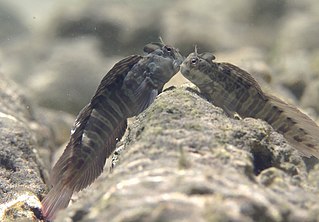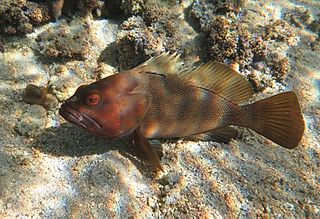
The green terror is a colorful freshwater fish in the cichlid family. The fish originates from the Pacific side of South America from the Tumbes River in Peru to the Esmeraldas River in Ecuador. It is polymorphic and can have white or gold-orange edging to the tail and dorsal fins. It has historically been confused with two other species that always have narrow, clearly defined white edging, the more southerly distributed A. stalsbergi and the more northerly A. blombergi.

Trichomycterus rivulatus is a species of pencil catfish that is native to high-altitude Andean streams and lakes in southern Peru, western Bolivia and northern Chile. It is the largest species in the genus Trichomycterus and grows to a maximum length of 37.4 centimetres (14.7 in) TL. The species is regularly caught as a food fish. However, because of pollution, studies have revealed levels of metals in T. rivulatus of Lake Titicaca that exceed the internationally recommended safety thresholds for human consumption.

The giant hawkfish, also known as the hieroglyphic hawkfish, is a species of marine ray-finned fish, a hawkfish belonging to the family Cirrhitidae. It is a marine fish and the largest of the hawkfish family with maximum size of 60 cm (24 in) in total length. It is found in the eastern Pacific Ocean.

The blue acara is a colorful freshwater fish in the cichlid family. This fish can be found in various freshwater habitats, ranging from standing water to flowing streams, in Venezuela and Trinidad. They can reach lengths of 16 cm (6.3 in). The scientific species name is indicative to its looks; pulcher meaning "beautiful" in Latin. The blue acara is a common cichlid sold in many aquarium stores, and is sometimes confused with the larger green terror.

Istiblennius is a genus of combtooth blennies found in the Pacific and Indian Oceans. The generic name is a compound noun composed of istio the Greek for "sail", referring to the high dorsal fin of the type species, Istiblennius muelleri, and blennius which is derived from a word for "mucus" and refers to the scaleless bodies that characterise the Blenniidae.

Istiblennius bellus, the imspringer, is a species of combtooth blenny found in coral reefs in the Pacific and western Indian Ocean. It is also known as the beautiful rockskipper or the dusky blenny. Males of this species can reach a maximum of 16 cm (6.3 in) SL, while females reach a maximum of 13.1 cm (5.2 in) SL.

Istiblennius edentulus, the rippled rockskipper, is a species of combtooth blenny found in coral reefs in the Pacific and Indian Oceans. It is also commonly known as the rippled blenny, smooth-lipped blenny, toothless blenny, or coral blenny. Males of this species can reach a maximum of 16 cm (6.3 in) TL, while females can reach a maximum of 13.2 cm (5.2 in) SL.
Istiblennius flaviumbrinus is a species of combtooth blenny found in the western Indian Ocean, specifically the Red Sea. Males of this species can reach a maximum of 9 cm (3.5 in) SL, while females can reach a maximum of 7.2 cm (2.8 in) SL.

Istiblennius lineatus, the lined rockskipper, is a species of combtooth blenny found in coral reefs in the Pacific and Indian oceans. It is also commonly known as the lined blenny, black-lined blenny, or thin-lined rockskipper. It can reach a maximum of 15 cm (5.9 in) TL. This species can be found in the aquarium trade.

Istiblennius meleagris, the peacock rockskipper, is a species of combtooth blenny found in coral reefs in the western Pacific ocean. It is also known as the white-speckled blenny. Males can reach a maximum of 15 cm (5.9 in) TL, while females can reach a maximum of 10.6 cm (4.2 in) SL.
Istiblennius muelleri, Mueller's rockskipper, is a species of combtooth blenny found in the western Pacific ocean. Males of this species can reach a maximum of 7 cm (2.8 in) SL, while females can reach a maximum of 5.5 cm (2.2 in) SL. The specific zoology honours the German-Australian physician, geographer, and botanist Ferdinand von Mueller (1825-1896).
Istiblennius pox, the scarface rockskipper, is a species of combtooth blenny found in the western Indian Ocean. It can reach a maximum of 13 cm (5.1 in) TL.

Istiblennius spilotus, the spotted rockskipper, is a species of combtooth blenny found in the western Indian Ocean. Males of this species can reach a maximum of 14 cm (5.5 in) TL, while females can reach a maximum length of 9.7 cm (3.8 in) SL.
Istiblennius steindachneri is a species of combtooth blenny found in the western Indian Ocean. It can reach a maximum of 11 cm (4.3 in) in SL. The identity of the person honoured in this blenny's specific name was not stated by Pfeffer in his description but it is almost certainly the Austrian ichthyologist Franz Steindachner (1834-1919).

Istiblennius unicolor, the pallid rockskipper, is a species of combtooth blenny found on coral reefs in the western Indian Ocean. Males of this species can reach a maximum standard length of 10.2 cm (4.0 in), while females can reach a maximum length of 9.2 cm (3.6 in).

Istiblennius zebra, Pāoʻo, the zebra blenny, is a species of combtooth blenny found in tide pools around the Hawaiian Islands. It is also commonly known as the zebra rockskipper, rockskipper, jumping jack or the gori.
Andinoacara stalsbergi is a species of South American freshwater fish in the family Cichlidae. It was previously included in A. rivulatus, but was described as a separate species in 2009. The specific name honours the Norwegian aquarist Alf Stalsberg who collected the type of this species and who has had a "longstanding commitment to increase the knowledge about cichlid fishes".

Lutjanus rivulatus, the blubberlip snapper, Maori snapper, blue-spotted seaperch, Maori bream, Maori seaperch, multi-coloured snapper, scribbled snapper, speckled snapper or yellowfin snapper, is a species of marine ray-finned fish, a snapper belonging to the family Lutjanidae. It is native to the Indian Ocean and into the Pacific Ocean.

Siganus rivulatus, the marbled spinefoot, rivulated rabbitfish or surf parrotfish, is a gregarious, largely herbivorous ray-finned fish of the family Siganidae. Its natural range encompasses the western Indian Ocean and the Red Sea from where it colonised the Mediterranean Sea by Lessepsian migration through the Suez Canal. It is the type species of the genus Siganus.

Epinephelus rivulatus, the halfmoon grouper, halfmoon rockcod, Chinaman rockcod, Charlie court cod, green-finned rock cod, or white-dotted grouper, is a species of marine ray-finned fish, a grouper from the subfamily Epinephelinae which is part of the family Serranidae, which also includes the anthias and sea basses. It is found in the Indo-Pacific region.















